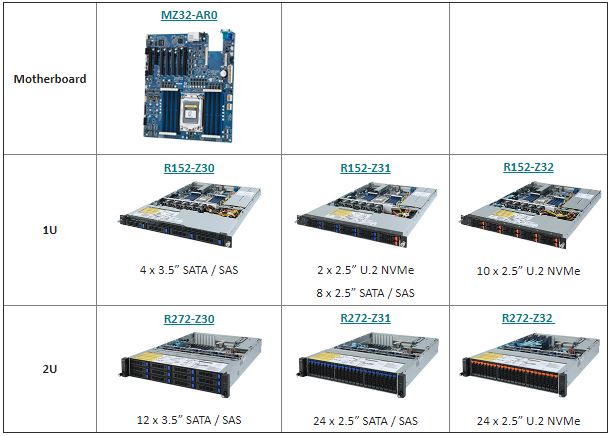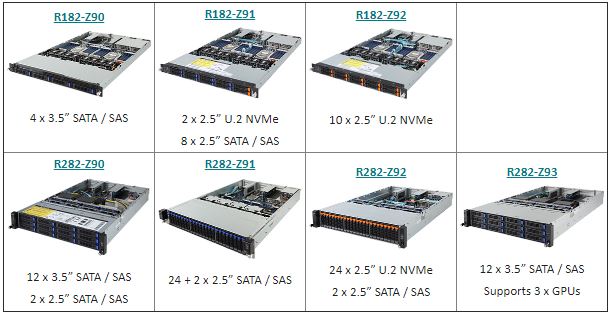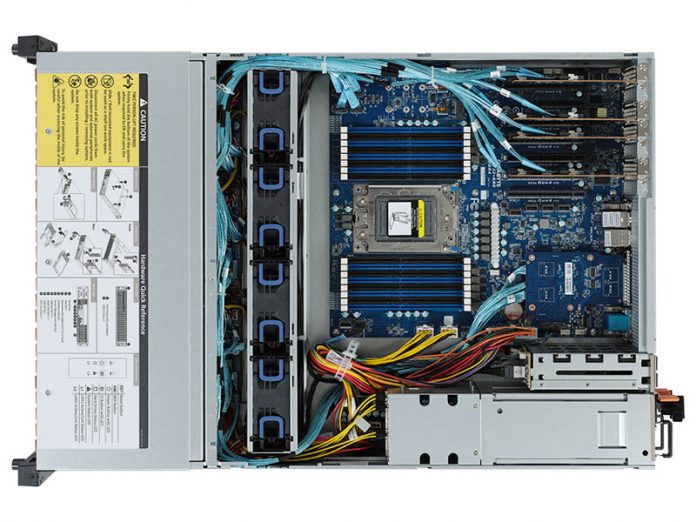Over the past few weeks, we have been working extensively with AMD EPYC 7002, codenamed “Rome.” You can read the industry’s most in-depth analysis on the AMD EPYC 7002 series including benchmarks on STH. What should be clear by now is that AMD now has the industry’s leading x86 processor. Recognizing this forthcoming advantage early, Gigabyte has jumped on the AMD EPYC 7002 launch with an unrivaled set of new systems in terms of sheer quantity. Gigabyte has 17 different systems and a motherboard for launch. The company also announced that it will be releasing new systems, such as a G-series GPU platform, over the next few months. This is an enormous launch portfolio.
Gigabyte Server AMD EPYC 7002 Launch Lineup
The Gigabyte AMD EPYC 7002 launch lineup of server platforms is very large. There are a number of platforms available. Gigabyte primarily has single-socket, dual-socket, and 2U4N platforms available
Gigabyte AMD EPYC 7002 Single Socket Platforms
The six AMD EPYC 7002 single-socket server offerings are built around the Gigabyte MZ32-AR0 motherboard. We reviewed its predecessor in our Gigabyte MZ31-AR0 review. Gigabyte uses this motherboard in three 1U and three 2U servers to achieve a wide range of storage and expansion options.

There are 1U and 2U 3.5″ servers, the Gigabyte R152-Z30 and R272-Z30. For 2.5″ options, there are options focused primarily on SATA/ SAS (R152-Z31 and R272-Z31) and NVMe (R152-Z32 and R272-Z32.) STH featured the Gigabyte R272-Z32 in our AMD EPYC 7002 lanch benchmark piece. Expect a full review soon on the platform.
Gigabyte AMD EPYC 7002 Dual Socket Platforms
The Gigabyte AMD EPYC 7002 dual-socket portfolio is large. There again are three 1U server offerings (R182-Z90, R182-Z91, R182-Z92) and three 2U offerings (R282-Z90, R282-Z91, and R282-Z92) that vary their storage capacities from four 3.5″ bays to 24x 2.5″ U.2 NVMe bays.

The company is going a step further with the Gigabyte R282-Z93. This is a 3x GPU 2U solution with dual AMD EPYC 7002 series CPU support. The Dell EMC PowerEdge R7415 has been popular with GPUs for video inferencing and analytics at the edge. Gigabyte is poised to provide a differentiated solution with the R282-Z93.
Gigabyte AMD EPYC 7002 2U4N Platforms
The Gigabyte AMD EPYC 7002 2U4N platforms are similar to what we saw with the first generation. At STH we reviewed both the Gigabyte H261-Z60 and Gigabyte H261-Z61 2U4N EPYC servers. These are the updates to that platform.

Gigabyte did a great job with a modular compute architecture which is allowing the company to be one of the first to market with dense AMD EPYC solutions.
Final Words
Expect more reviews coming in the following months. Gigabyte’s product teams have done a great job tracking new industry trends. The fact that the company has the largest AMD EPYC 7002 portfolio at launch, with more coming, shows that they have taken customer feedback seriously. As new architectures are launched, Gigabyte is often one of the first companies in the market with a portfolio of solutions. That alone is a major differentiator with for the company. The Gigabyte AMD EPYC 7002 lineup is a prime example of this.





If the main board can handle PCIe4 signalling then the fact that EPYC is a SOC means you just swap the CPU and voila, a new product line! Very nice!
I’m laughing a bit as I write this, because nevermind disruptive, this is the most subversive thing I’ve seen in 26 years in the IT racket.
I remember too clearly how incompatible systems and expansion busses made me throw my arms into the air and refuse to take the PC seriously for several critical years in business (take the opposite direction to me during any technology revolution) ,
The idea of upgrading the peripheral expansion busses when dropping a new CPU into a motherboard, has confounded me with how I’m to feel: joy and relief for my imminent computing needs, or genuine complaint that this is a decade or three late? But this is very definitely the way to do expansion. Bravo.